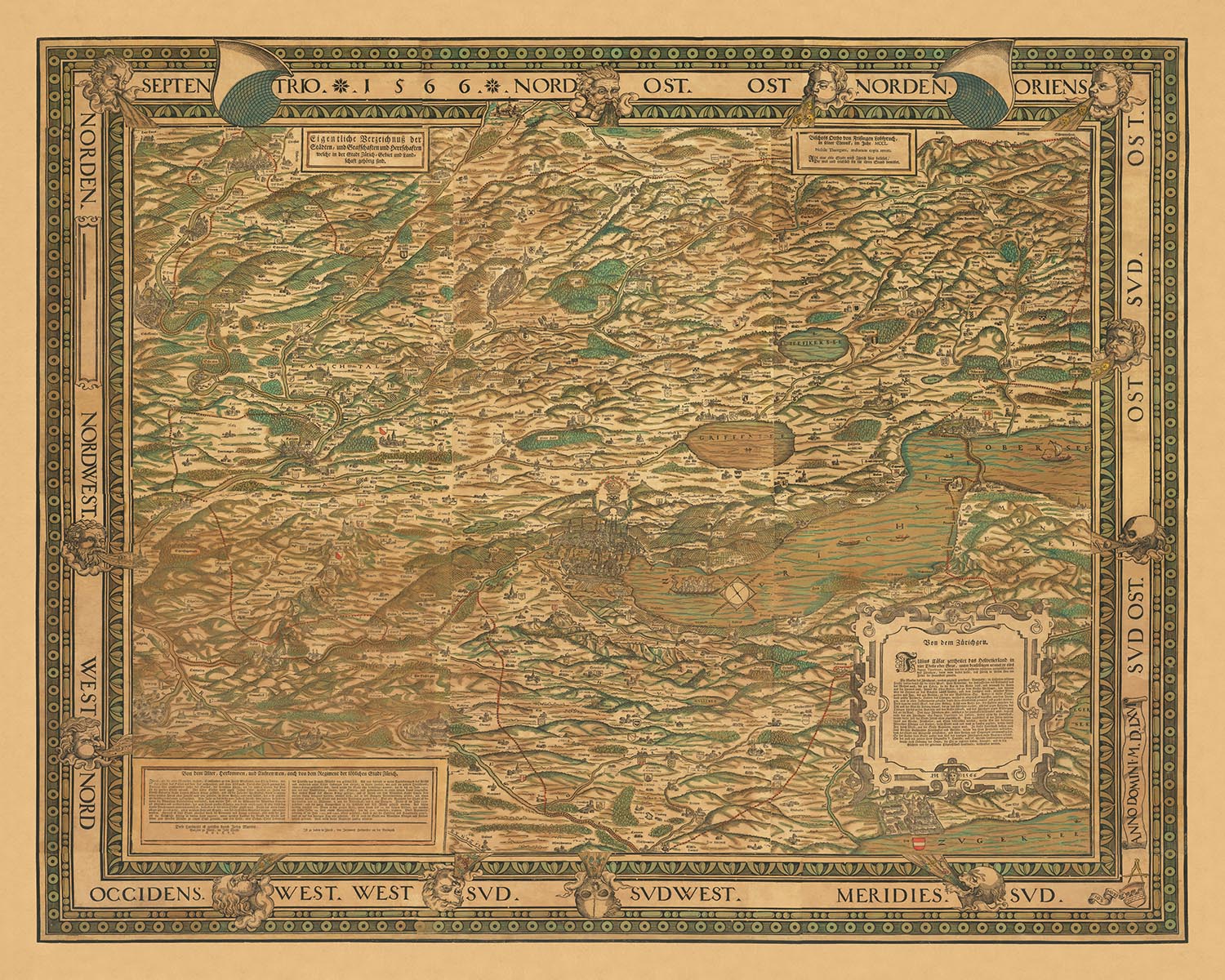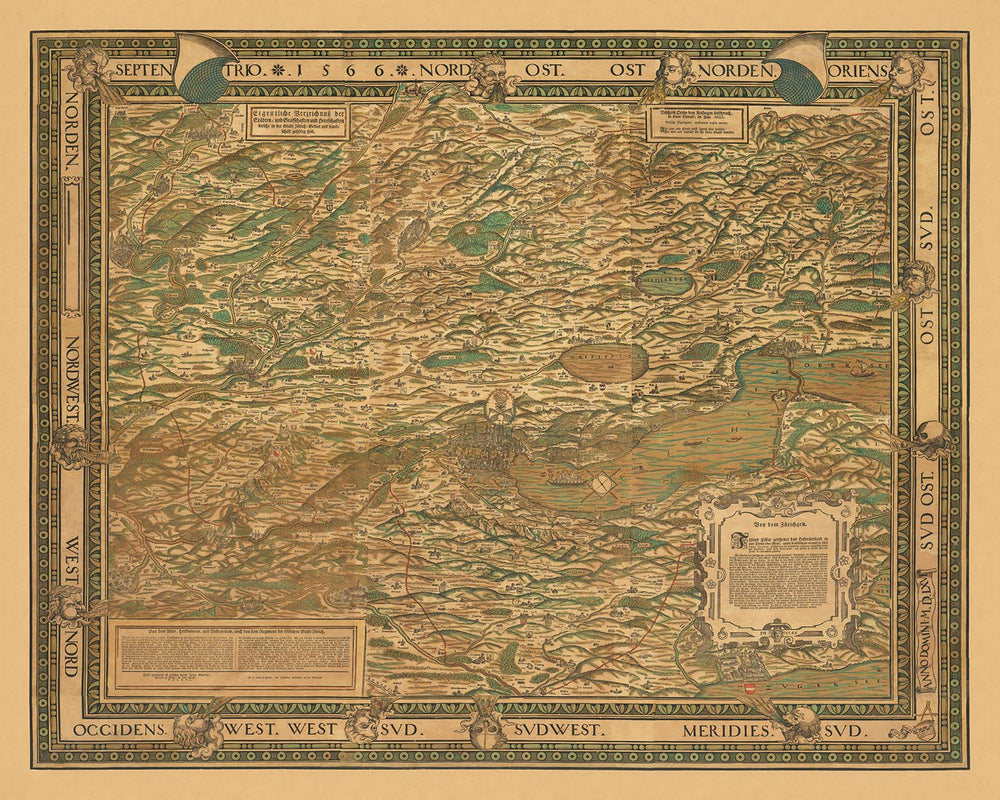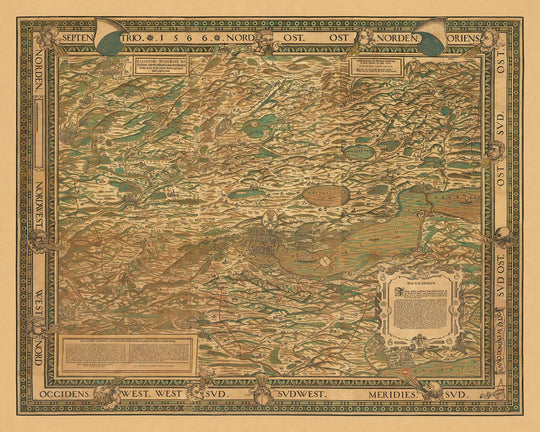- Handmade locally. No import duty or tax
- FREE worldwide delivery
- Love it or your money back (90 days)
- Questions? WhatsApp me any time
Own a piece of history
5,000+ 5 star reviews


The "Eigentliche Verzeichnuss der Stätten, Graffschafften vnd Herrschafften, welche in der Statt Zürich Gebiet vnd Landscafft gehörig seind" is a masterful creation by the renowned cartographer Jodocus Murer, dating back to 1566. This exquisite map provides a bird's eye view of the canton of Zurich, capturing the essence of the region with remarkable detail and artistry. Murer's dedication to his craft is evident in the intricate depiction of cities, settlements, and the diverse landscape, offering a glimpse into the 16th-century geography and administrative divisions of Zurich.
The map is oriented northeast, a unique feature that adds to its historical charm. The decorative border is adorned with windheads and fierce skulls, each meticulously detailed, adding a touch of Renaissance artistry to the map. The compass rose in Lake Zurich and the shields bearing Zurich's coat of arms further enhance the map's visual appeal. At the bottom right, the coat of arms and name of Jodocus Murer, along with a pair of dividers, proudly mark the mapmaker's identity and craftsmanship.
Jodocus Murer's map is not just a geographical representation but a historical document that narrates the story of Zurich. The cartouches on the map provide valuable historical context, including a dedication to Bishop Otto von Friezinger and a detailed history of the canton of Zurich. The map delineates administrative boundaries with dotted lines, showcasing the political landscape of the time. The hilly and mountainous terrain, along with the many lakes and rivers, are vividly illustrated, offering a comprehensive view of the region's natural features.
The cities and towns are depicted with distinguishing architectural details, often featuring prominent churches and coats of arms. Zurich, the largest settlement, is prominently displayed with its city walls and the iconic twin-towered Grossmünster church. The map also highlights the wealth of detail in smaller towns and villages, each contributing to the rich tapestry of Zurich's historical and cultural heritage. This meticulous attention to detail makes the map an invaluable resource for historians and enthusiasts alike.
The historical significance of Murer's map extends beyond its aesthetic appeal. It serves as a testament to the cartographic techniques and artistic sensibilities of the Renaissance period. The map's ability to convey both the geographical and cultural landscape of Zurich in the 16th century makes it a treasured artifact. Whether you are a collector, historian, or simply an admirer of fine cartography, this map offers a captivating journey through time, revealing the intricate beauty and historical depth of the canton of Zurich.
Cities and towns on this map
- Zurich
- Winterthur
- Uster
- Dübendorf
- Dietikon
- Wetzikon
- Horgen
- Bülach
- Adliswil
- Thalwil
- Regensdorf
- Wallisellen
- Rüti
- Schlieren
- Opfikon
- Kloten
- Meilen
- Affoltern am Albis
- Volketswil
- Männedorf
- Wädenswil
- Hinwil
- Rümlang
- Zollikon
Notable Features & Landmarks
- Compass rose in Lake Zurich
- Decorative border with windheads and skulls
- Two shields with Zurich's coat of arms
- Coat of arms and name of Jodocus Murer with a pair of dividers
- Cartouche with dedication to Bishop Otto von Friezinger
- History of the canton of Zurich in the lower left cartouche
- History cartouche with strapwork border in the lower right
- Detailed depiction of hilly and mountainous terrain
- Representation of lakes and rivers, including Lake Zurich
- City walls and buildings of Zurich, including the Grossmünster church
Historical and design context
- Created in 1566 by Jodocus Murer (1530-1580)
- The map is a bird's eye view pictorial map, printed in monochrome and oriented northeast
- The map is decorated with a border featuring detailed windheads and skulls
- The map provides a wealth of historical detail about the canton of Zurich in the 16th century
- It reflects the cartographic style and techniques of the Renaissance period
- The map is a valuable historical document for understanding the geography and administrative divisions of Zurich in the 16th century
- The cartouches on the map provide valuable historical context, including a dedication to Bishop Otto von Friezinger and a detailed history of the canton of Zurich
- The map delineates administrative boundaries with dotted lines, showcasing the political landscape of the time
- Architectural details of towns and villages, including churches and coats of arms, are meticulously illustrated
Please double check the images to make sure that a specific town or place is shown on this map. You can also get in touch and ask us to check the map for you.
This map looks great at every size, but I always recommend going for a larger size if you have space. That way you can easily make out all of the details.
This map looks amazing at sizes all the way up to 100in (250cm). If you are looking for a larger map, please get in touch.
Please note: the labels on this map are hard to read if you order a map that is 16in (40cm) or smaller. The map is still very attractive, but if you would like to read the map easily, please buy a larger size.
The model in the listing images is holding the 16x20in (40x50cm) version of this map.
The fifth listing image shows an example of my map personalisation service.
If you’re looking for something slightly different, check out my collection of the best old maps to see if something else catches your eye.
Please contact me to check if a certain location, landmark or feature is shown on this map.
This would make a wonderful birthday, Christmas, Father's Day, work leaving, anniversary or housewarming gift for someone from the areas covered by this map.
This map is available as a giclée print on acid free archival matte paper, or you can buy it framed. The frame is a nice, simple black frame that suits most aesthetics. Please get in touch if you'd like a different frame colour or material. My frames are glazed with super-clear museum-grade acrylic (perspex/acrylite), which is significantly less reflective than glass, safer, and will always arrive in perfect condition.
This map is also available as a float framed canvas, sometimes known as a shadow gap framed canvas or canvas floater. The map is printed on artist's cotton canvas and then stretched over a handmade box frame. We then "float" the canvas inside a wooden frame, which is available in a range of colours (black, dark brown, oak, antique gold and white). This is a wonderful way to present a map without glazing in front. See some examples of float framed canvas maps and explore the differences between my different finishes.
For something truly unique, this map is also available in "Unique 3D", our trademarked process that dramatically transforms the map so that it has a wonderful sense of depth. We combine the original map with detailed topography and elevation data, so that mountains and the terrain really "pop". For more info and examples of 3D maps, check my Unique 3D page.
For most orders, delivery time is about 3 working days. Personalised and customised products take longer, as I have to do the personalisation and send it to you for approval, which usually takes 1 or 2 days.
Please note that very large framed orders usually take longer to make and deliver.
If you need your order to arrive by a certain date, please contact me before you order so that we can find the best way of making sure you get your order in time.
I print and frame maps and artwork in 23 countries around the world. This means your order will be made locally, which cuts down on delivery time and ensures that it won't be damaged during delivery. You'll never pay customs or import duty, and we'll put less CO2 into the air.
All of my maps and art prints are well packaged and sent in a rugged tube if unframed, or surrounded by foam if framed.
I try to send out all orders within 1 or 2 days of receiving your order, though some products (like face masks, mugs and tote bags) can take longer to make.
If you select Express Delivery at checkout your order we will prioritise your order and send it out by 1-day courier (Fedex, DHL, UPS, Parcelforce).
Next Day delivery is also available in some countries (US, UK, Singapore, UAE) but please try to order early in the day so that we can get it sent out on time.
My standard frame is a gallery style black ash hardwood frame. It is simple and quite modern looking. My standard frame is around 20mm (0.8in) wide.
I use super-clear acrylic (perspex/acrylite) for the frame glass. It's lighter and safer than glass - and it looks better, as the reflectivity is lower.
Six standard frame colours are available for free (black, dark brown, dark grey, oak, white and antique gold). Custom framing and mounting/matting is available if you're looking for something else.
Most maps, art and illustrations are also available as a framed canvas. We use matte (not shiny) cotton canvas, stretch it over a sustainably sourced box wood frame, and then 'float' the piece within a wood frame. The end result is quite beautiful, and there's no glazing to get in the way.
All frames are provided "ready to hang", with either a string or brackets on the back. Very large frames will have heavy duty hanging plates and/or a mounting baton. If you have any questions, please get in touch.
See some examples of my framed maps and framed canvas maps.
Alternatively, I can also supply old maps and artwork on canvas, foam board, cotton rag and other materials.
If you want to frame your map or artwork yourself, please read my size guide first.
My maps are extremely high quality reproductions of original maps.
I source original, rare maps from libraries, auction houses and private collections around the world, restore them at my London workshop, and then use specialist giclée inks and printers to create beautiful maps that look even better than the original.
My maps are printed on acid-free archival matte (not glossy) paper that feels very high quality and almost like card. In technical terms the paper weight/thickness is 10mil/200gsm. It's perfect for framing.
I print with Epson ultrachrome giclée UV fade resistant pigment inks - some of the best inks you can find.
I can also make maps on canvas, cotton rag and other exotic materials.
Learn more about The Unique Maps Co.
Map personalisation
If you're looking for the perfect anniversary or housewarming gift, I can personalise your map to make it truly unique. For example, I can add a short message, or highlight an important location, or add your family's coat of arms.
The options are almost infinite. Please see my map personalisation page for some wonderful examples of what's possible.
To order a personalised map, select "personalise your map" before adding it to your basket.
Get in touch if you're looking for more complex customisations and personalisations.
Map ageing
I have been asked hundreds of times over the years by customers if they could buy a map that looks even older.
Well, now you can, by selecting Aged before you add a map to your basket.
All the product photos you see on this page show the map in its Original form. This is what the map looks like today.
If you select Aged, I will age your map by hand, using a special and unique process developed through years of studying old maps, talking to researchers to understand the chemistry of aging paper, and of course... lots of practice!
If you're unsure, stick to the Original colour of the map. If you want something a bit darker and older looking, go for Aged.
If you are not happy with your order for any reason, contact me and I'll get it fixed ASAP, free of charge. Please see my returns and refund policy for more information.
I am very confident you will like your restored map or art print. I have been doing this since 1984. I'm a 5-star Etsy seller. I have sold tens of thousands of maps and art prints and have over 5,000 real 5-star reviews. My work has been featured in interior design magazines, on the BBC, and on the walls of dozens of 5-star hotels.
I use a unique process to restore maps and artwork that is massively time consuming and labour intensive. Hunting down the original maps and illustrations can take months. I use state of the art and eye-wateringly expensive technology to scan and restore them. As a result, I guarantee my maps and art prints are a cut above the rest. I stand by my products and will always make sure you're 100% happy with what you receive.
Almost all of my maps and art prints look amazing at large sizes (200cm, 6.5ft+) and I can frame and deliver them to you as well, via special oversized courier. Contact me to discuss your specific needs.
Or try searching for something!















































